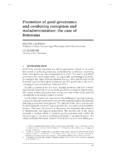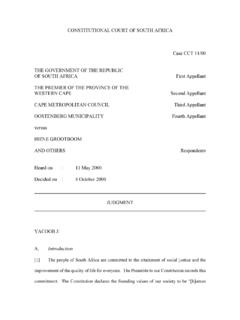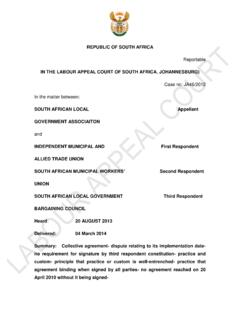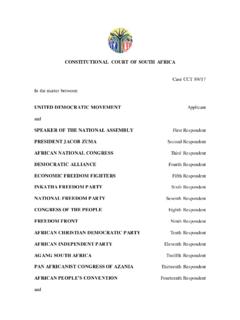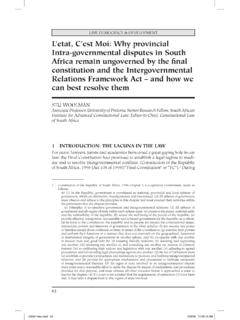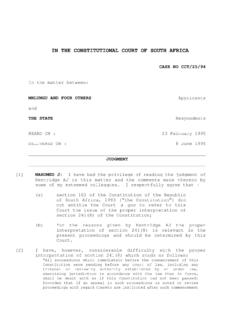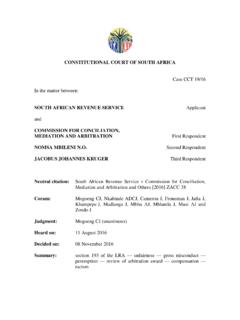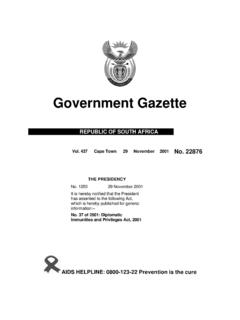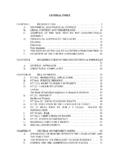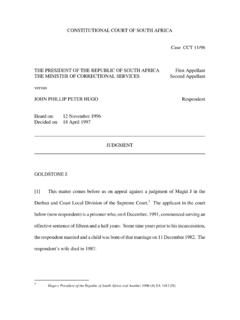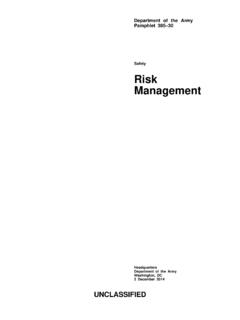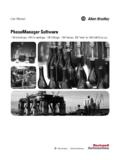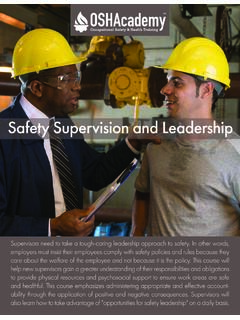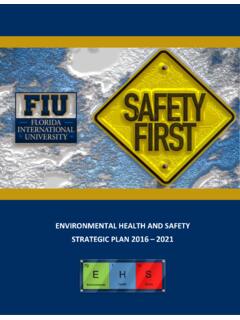Transcription of ENVIRONMENTAL REGULATIONS FOR WORKPLACES
1 OCCUPATIONAL HEALTH AND SAFETY ACT Act 85 of 1993. ENVIRONMENTAL REGULATIONS FOR WORKPLACES [Updated to 7 March 2003] GoN R2281, G. 10988 ( 16 October 1987), GoN R1754, G. 12054 ( 18 August 1989), GoN R489, G. 15560 ( 18 March 1994), GoN R307, G. 24967 ( 7 March 2003). [Editor Note: These REGULATIONS were published in terms of the Machinery and Occupational Safety Act, 1983 (Act 6 of 1983) and are now in force in terms of the Occupational Health and Safety Act 85 of 1993.] The Minister of Manpower has, in terms of section 35 of the Machinery and Occupational Safety Act, 1983 (Act 6 of 1983), made the REGULATIONS contained in the Schedule hereto. ARRANGEMENT OF REGULATIONS 1. Definitions 2. Thermal requirements 3. Lighting 4. Windows 5.
2 Ventilation 6. Housekeeping 7.. 8. Precautions against flooding 9. Fire precautions and means of egress 10. Offences and penalties 11. Withdrawal of REGULATIONS 12. Short title 1. Definitions In these REGULATIONS the Act means the Machinery and Occupational Safety Act, 1983 (Act 6 of 1983), and any expression to which a meaning has been assigned in the Act shall have the meaning so assigned and, unless the context indicates otherwise acclimatised means physiologically adapted to a particular thermal environment and work rate; attenuation means the proven capability of hearing protectors to reduce the equivalent noise level to which the wearer thereof is exposed; building work means work defined as such in regulation 1 of the General Administrative REGULATIONS promulgated in terms of section 35 of the Act and published under Government Notice of 5 October 1984.
3 DB (A) means a unit of measurement of sound pressure level as contemplated in SABS 083; directional luminaire means a luminaire from which the light radiation is confined to a well-defined narrow beam; equivalent sound pressure level is the value of the equivalent continuous sound level which would deliver the same amount of sound energy as the actual fluctuating sound, measured over the same time period, and equivalent noise level has a corresponding meaning; [ equivalent sound pressure level subs by equivalent noise level by reg 2(b) of GoN R489 in G. 15560.] exposed means exposed whilst at work, and exposure has a corresponding meaning; [ exposed ins by reg 2(a) of GoN R489 in G. 15560.] exposure limit means a value as defined in the Asbestos REGULATIONS , 1987, promulgated in terms of section 35 of the Act and published under Government Notice of 10 April 1987; hearing protectors means ear muffs or ear plugs of a type approved by the chief inspector and in respect of which an efficiency test as prescribed by SABS 572 has been conducted by the South African Bureau of Standards or an approved inspection authority; heatstroke means a pathological condition arising from thermoregulatory failure of the human body; illuminance means the intensity of light falling on a surface, measured in lux; luminaire means a light fitting which supports a lamp and provides it with electrical connections.
4 Noise zone means an area where the equivalent noise level is equal to or exceeds 85 dB (A) when measured in accordance with SABS 083; regional director means the regional director as defined in regulation 1 of the General Administrative REGULATIONS published under Government Notice of 5 October 1984 and amended by Government Notice of 1990; [ regional director ins by reg 2(e) of GoN R489 in G. 15560.] respiratory protective equipment means a device as defined in the Asbestos REGULATIONS , 1987, promulgated in terms of section 35 of the Act and published under Government Notice of 10 April 1987; SABS 083 means the South African Bureau of Standards Code of Practice for the Measurement and Assessment of Occupational Noise for Hearing Conservation Purposes, SABS 083; SABS 572.
5 [ SABS 572 rep by reg 2(c) of GoN R489 in G. 15560.] SABS 1451: Part I South African Standard. Standard Specification for Hearing Protectors, Part I: Ear muffs; [ SABS 1451 Part I ins by reg 2(d) of GoN R489 in G. 15560.] SABS 1451: Part II South African Standard. Standard Specification for Hearing Protectors, Part II: Ear plugs; [ SABS 1451 Part II ins by reg 2(d) of GoN R489 in G. 15560.] time-weighted average means the average of a number of representative measurements that are taken over a period of time and that are calculated as follows Time-Weighted average = x1 t1 + x2 t2 + x3 t3 + .. + xn tn _____ t1 + t2 + t3 + .. + tn where x1, x2, etc., -are the observed measurements during the corresponding periods t1, t2, etc., minutes, and t1 + t2 + t3 + .. + tn is the total time in minutes over which the measurements are taken; WBGT index means a number which characterises the thermal conditions in the environment to which that number applies; it is calculated by adding seven tenths of the reading in degrees Celsius obtained with a naturally ventilated wet-bulb thermometer to one fifth of the reading in degrees Celsius obtained with a globe thermometer and adding that sum to one tenth of the reading in degrees Celsius obtained with a dry-bulb thermometer; the index may also be obtained by using an electronically integrating direct-reading instrument which has been designed, built and calibrated for that particular purpose.
6 Working plane means a horizontal plane at the level where work is performed. 2. Thermal requirements (1) Subject to the provisions of subregulation (2), no employer shall require or permit an employee to work in an environment in which the time-weighted average dry-bulb temperature taken over a period of four hours is less than 6 C, unless the employer takes reasonable measures to protect such employee against the cold and further takes all precautions necessary for the safety of such employee: Provided that, where outdoor work is performed, the employer shall take such measures and such precautions in an environment in which the actual dry-bulb temperature is less than 6 C at any time. [Reg 2(1) subs by reg 2 of GoN R1754 in G. 12054.] (2) No employer shall require or permit an employee to work in a refrigerated environment in which the actual dry-bulb temperature is below 0 C unless--- (a) the maximum exposure of the employee does not exceed the periods as indicated in the following table: Temperature (Celsius) Maximum exposure 0 to - 18 degrees No limit.
7 Lower than -18 but not lower than -34 degrees Maximum continuous exposure during each hour: 50 minutes. After every exposure in a low-temperature area at least 10 minutes must be spent, under supervision, in a comfortably warm environment. Lower than -34 but not lower than -57 degrees Two periods of 30 minutes each, at least 4 hours apart. Total low-temperature exposure: 1 hour per day. Lower than -57 degrees Maximum permissible exposure: 5 minutes during any 8-hour period. (b) the employee is provided with the following protective clothing (i) A nylon freezer suit or equivalent and, where the said temperature is below -34 C, such suit or equivalent shall be of double layer; (ii) a woollen Balaclava or equivalent; (iii) fur-lined leather gloves or equivalent; (iv) waterproof outer gloves with knitted woollen or equivalent inners as well as a waterproof apron where wet or thawing substances are handled; (v) woollen socks; and (vi) waterproof industrial boots or equivalent: Provided that an employee who works in a low-temperature area in which the temperature is not lower than -18 C for periods not exceeding five minutes in every hour need only be provided with an ordinary overall, gloves and shoes, or equivalent.
8 (c) the employee is, beforehand and thereafter, at intervals not exceeding one year, certified fit to work in such environment by a registered medical practitioner or a registered nurse according to a protocol prescribed by such practitioner, and such employee is issued with a certificate to that effect; and (d) all the clothing worn by the employee is dry prior to entering the low-temperature area. (3) Where hand-held tools which vibrate at a frequency of vibration of less than 1 000 Hz are used at an actual dry-bulb temperature below 6 C, the employer shall provide an employee operating such tools with lined gloves, and ensure that he wears them. (4) Where the time-weighted average WBGT index, determined over a period of one hour, exceeds 30 in the environment in which an employee works, the employer of such employee shall (a) if practicable, take steps to reduce the said index to below 30; or (b) where it is not practicable to reduce the said index to below 30 and where hard manual labour is performed (i) have every such employee beforehand and thereafter, at intervals not exceeding one year, certified fit to work in such environment by a registered medical practitioner or a registered nurse according to a protocol prescribed by such practitioner, and every such employee shall, if found fit to work in such environment, be issued with a certificate to that effect by such practitioner or nurse.
9 (ii) ensure that every such employee is acclimatised to such working environment before he is required or permitted to work in such environment; (iii) inform every such employee of the need to partake of at least 600 millilitres of water every hour; (iv) train every such employee in the precautions to be taken to avoid heatstroke; and (v) provide the means whereby every such employee can receive prompt first-aid treatment in the event of heatstroke: Provided that, where the question arises as to whether any particular type of work does in fact constitute hard manual labour, the decision of an inspector shall be decisive. 3. Lighting (1) Every employer shall cause every workplace in his undertaking to be lighted in accordance with the illuminance values specified in the Schedule to these REGULATIONS : Provided that where specialised lighting is necessary for the performance of any particular type of work, irrespective of whether that type of work is listed in the Schedule or not, the employer of those employees who perform such work shall ensure that such specialised lighting is available to and is used by such employees.
10 (2) The chief inspector may, by notice in the Gazette, from time to time modify the Schedule to these REGULATIONS as he deems necessary. (3) With respect to the lighting to be provided in terms of subregulation (1), the employers shall ensure that (a) the average illuminance at any floor level in a work- place within five metres of a task is not less than one fifth of the average illuminance on that task; (b) glare in any workplace is reduced to a level that does not impair vision; (c) lighting on rotating machinery is such that the hazard of stroboscopic effect is eliminated; and (d) luminaires and lamps are kept clean and, when defective, are replaced or repaired forthwith. (4) With a view to the emergency evacuation of indoor WORKPLACES without natural lighting or in which persons habitually work at night, every employer shall, in such WORKPLACES , provide emergency sources of lighting which are such that, when activated, an illuminance of not less than 0,3 lux is obtained at floor level to enable employees to evacuate such WORKPLACES : Provided that where it is necessary to stop machinery or shut down plant or processes before evacuating the workplace , or where dangerous materials are present or dangerous processes
